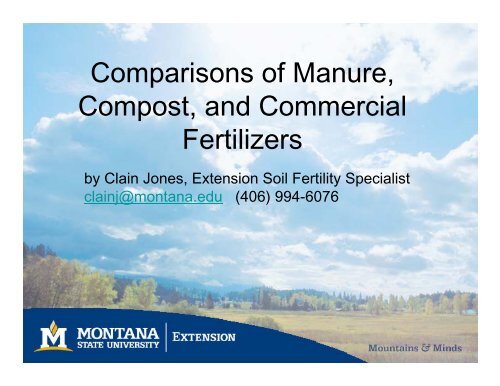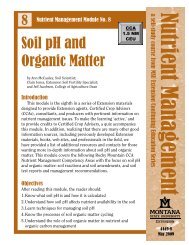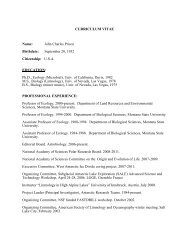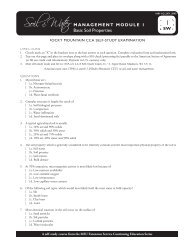Comparisons of Manure Comparisons of Manure, Compost, and ...
Comparisons of Manure Comparisons of Manure, Compost, and ...
Comparisons of Manure Comparisons of Manure, Compost, and ...
Create successful ePaper yourself
Turn your PDF publications into a flip-book with our unique Google optimized e-Paper software.
<strong>Comparisons</strong> <strong>of</strong> <strong>Manure</strong> <strong>Manure</strong>,<br />
<strong>Compost</strong>, p <strong>and</strong> Commercial<br />
Fertilizers<br />
by Clain Jones, Extension Soil Fertility Specialist<br />
clainj@montana.edu (406) 994-6076
<strong>Manure</strong> <strong>Manure</strong>, <strong>Compost</strong> <strong>and</strong> Fertilizer<br />
All 3 materials provide crops with NN, PP, <strong>and</strong> KK, so why<br />
choose one over the other?<br />
•Differences in nutrient content<br />
•Effects on plant yield yield, vigor <strong>and</strong> health<br />
•Effects on soil tilth<br />
•Transportation, application <strong>and</strong> cost<br />
differences
• Commercial fertilizers : AA, AN, UAN, UR (Urea) MAP, DAP etc.<br />
• <strong>Manure</strong>: No explanation needed!!<br />
• <strong>Compost</strong>: Decomposed/stabilized organic matter<br />
<strong>Compost</strong> examples include:<br />
• Food Processing Residuals—compostable material remaining after fruit, vegetables,<br />
grains, nuts, <strong>and</strong> meat are processed for consumption.<br />
• <strong>Manure</strong> <strong>and</strong> Agricultural By-Products—originate at feed lots, on the farm, <strong>and</strong> in<br />
greenhouses. Large quantities <strong>of</strong> manures <strong>and</strong>/or plant residues are generated <strong>and</strong> can<br />
pose a severe disposal problem.<br />
• Forestry <strong>and</strong> Forest Product Residuals—includes bark <strong>and</strong> sawdust, <strong>and</strong> fiber fines,<br />
residue <strong>and</strong> biosolids generated by the papermaking process.<br />
• Biosolids, or Sewage Sludge—the solid material generated by the biological treatment<br />
<strong>of</strong> f sewage at a wastewater treatment plant. In addition to being composted, sewage<br />
sludge can be recycled for beneficial use by direct application to l<strong>and</strong> as a fertilizer.<br />
• Leaves, Brush <strong>and</strong> Yard Trimmings (Yard Waste)—typically consists <strong>of</strong> leaves,<br />
brush brush, <strong>and</strong> grass clippings common to urban areas areas.<br />
Source The <strong>Compost</strong>ing Council Research <strong>and</strong> Education Foundation (CCREF)
Advantages<br />
Commercial Fertilizers<br />
• Precise amount <strong>of</strong> N, P, K<br />
• Available in a range <strong>of</strong> nutrient levels<br />
(especially when blended) to provide the<br />
producer what is needed for the crop<br />
• Uniform material for ease <strong>of</strong> transport <strong>and</strong><br />
application<br />
• Known properties <strong>of</strong> the material with<br />
predictable effect on crops<br />
• Widely available
Commercial Fertilizers<br />
Disadvantages<br />
• CCosts t vary <strong>and</strong> d change h dduring i th the year, <strong>and</strong> d<br />
are currently at record highs<br />
• Often have higher chance for nutrient run<strong>of</strong>f<br />
or leaching leaching, because <strong>of</strong> high solubility
Advantages d a tages<br />
<strong>Manure</strong>s<br />
• Often free (except for transport/application)<br />
• Adds organic matter (OM) to the soil which<br />
improves structure, increases water holding<br />
capacity, increases CEC <strong>and</strong> reduces erosion<br />
• Provides both available <strong>and</strong> ‘slow-release’ N,<br />
P, K <strong>and</strong> micro-nutrients to crops p
Disadvantages<br />
<strong>Manure</strong>s<br />
• Nutrients can be easily leached through the<br />
soil pr<strong>of</strong>ile or volatilized if left on the surface<br />
• Nutrient content is highly variable<br />
• May introduce human pathogenic bacteria<br />
such h as ffecal l coliform lif or EE.coli li<br />
• May introduce weed seeds<br />
• Weight <strong>and</strong> bulk <strong>of</strong> transporting <strong>and</strong> applying<br />
wet manures to fields
How is <strong>Manure</strong> Typically yp y H<strong>and</strong>led?<br />
<strong>Manure</strong> is <strong>of</strong>ten surface applied, pp incorporated p or<br />
injected into the soil without processing, <strong>and</strong><br />
applied at maximum allowable quantities to avoid<br />
building extensive storage facilities.<br />
These rates vary widely due to manure types, soil type <strong>and</strong><br />
method <strong>of</strong> application….Contact pp<br />
the NRCS for assistance in<br />
calculating manure application rates.<br />
Montana NRCS State Office<br />
(406) 587-6813<br />
Online <strong>Manure</strong> Nutrient Calculator<br />
http://www.agry.purdue.edu/mmp/webcalc/nutAvail.asp
Advantages<br />
<strong>Compost</strong> p<br />
• Lower water content: greater total concentration <strong>of</strong><br />
nutrients than manure on wet basis<br />
• Add Adds OM th that t releases l nutrients t i t slowly l l<br />
• High OM content improves soil structure, increases<br />
CEC <strong>and</strong> water holding capacity<br />
– Greater water holding capacity may decrease<br />
irrigation needs <strong>and</strong> reduce pumping costs<br />
• Beneficial microbes in compost increase nutrient<br />
cycling <strong>and</strong> can suppress soil <strong>and</strong> foliar pathogens
Advantages to <strong>Compost</strong> <strong>Compost</strong>, Cont Cont’dd<br />
• Few to no pathogens p g & weed seeds due to<br />
the heat generated during decomposition<br />
• Drier than manures with a reduced volume <strong>of</strong><br />
50 50-75%, 75% making ki iit easier i to transport <strong>and</strong> d<br />
apply<br />
• Possible source <strong>of</strong> income for various markets<br />
<strong>and</strong> applications<br />
• Market examples: p <strong>Compost</strong> p can be used by y home<br />
gardeners, mine reclamation sites, as seed starter<br />
<strong>and</strong> potting mixes for nurseries, as a soil<br />
amendment for l<strong>and</strong>scaping. p g
<strong>Compost</strong><br />
Disadvantages g<br />
• Making compost involves costly equipment,<br />
planning, monitoring <strong>and</strong> time to produce<br />
• Nutrient enriched leachate must be controlled<br />
to prevent run<strong>of</strong>f or ground water<br />
contamination<br />
• May require special permits depending on<br />
quantity qua t ty produced p oduced a<strong>and</strong> d if se selling g co compost post<br />
• Will likely be more costly per lb <strong>of</strong> available<br />
nutrient than either fertilizer or manure
Making g <strong>Compost</strong> p
Typical Total Nutrients in Fertilizer<br />
Fertilizer Sources<br />
Frequently Used<br />
Abbreviations<br />
% N % P 2O 5 % K 2O<br />
Anhydrous<br />
Ammonia<br />
AA 82 - -<br />
Ammonium nitrate AN 34 - -<br />
Urea-ammonium<br />
nitrate<br />
UAN 28-32 - -<br />
Monoammonium<br />
phosphate<br />
MAP 11 11-13 13 48 48-62 62 -<br />
Diammonium<br />
phosphate<br />
DAP 18-21 46-54 -<br />
Potassium chloride KCl - - 60<br />
Urea UR 46 - -<br />
(Modified from Havlin et al., 1999)
Typical Total Nutrients for <strong>Manure</strong><br />
National averages <strong>of</strong> nitrogen (N), phosphorus (P205), <strong>and</strong> potassium (K2O) values <strong>of</strong><br />
manures based on a dry weight <strong>and</strong> a wet weight basis.*<br />
% Dry Weight<br />
% Wet Weight<br />
Source<br />
%<br />
Dry Matter Total N Total P2O5 Total K2O Total N Total P2O5 Total K2O<br />
Dairy 15-25 0.6-2.1 0.7-1.1 2.4-3.6 0.1-0.5 0.1-0.3 0.4-0.9<br />
Feedlot 20-40 1.0-2.5 0.9-1.6 2.4-3.6 0.2-1.0 0.2-0.6 0.5-1.4<br />
Horse 16-25 1.7-3.0 0.7-1.2 1.2-2.2 0.3-0.8 0.1-0.3 0.2-0.6<br />
Poultry 20-30 2.0-4.5 4.5-5.0 1.2-2.4 0.4-1.4 0.9-1.5 0.2-0.7<br />
Sheep 25-35 3.0-4.0 1.2-1.6 3.0-4.0 0.8-1.4 0.3-0.6 0.8-1.4<br />
Swine 20-30 3.0-4.0 0.4-0.6 0.5-1.0 0.6-1.2 0.1-0.2 0.1-0.3<br />
*To determine actual amounts <strong>of</strong> nutrients, however, it is necessary to have the manure<br />
tested tested. Source: Knott Knott'ss H<strong>and</strong>book for Vegetable Growers. Growers 1997. 1997 John Wiley & Sons, Sons<br />
Inc. 4
Typical Nutrients in <strong>Compost</strong><br />
Typical nutrient breakdown <strong>of</strong> finished compost<br />
Nutrient Dry Weight<br />
Nitrogen (N)
NNutrient t i t Availability A il bilit iis Diff Different t ffor<br />
each Source<br />
Type <strong>of</strong> Nutrient Source Relative Nutrient Availability<br />
Commercial Fertilizer High<br />
<strong>Manure</strong> High -Medium , depending on<br />
liquid/solid<br />
<strong>Compost</strong> Low Low, slow release <strong>of</strong> nutrients
Comparing Yields Using Fertilizer<br />
Annual fertilizer rates<br />
(lb/A) 33-30-30<br />
(1930-1967), <strong>and</strong> 60-<br />
30-30 (1968-2000).<br />
<strong>Manure</strong> applied every<br />
4th 4 year at rates <strong>of</strong><br />
120 lb/A (1930-1967)<br />
<strong>and</strong> 240 lb/A (1968-<br />
2000).<br />
Grain Yieeld<br />
(bu/AA)<br />
45<br />
40<br />
35<br />
30<br />
25<br />
20<br />
15<br />
vs. M<strong>Manure</strong><br />
Comparing Winter Wheat Yields Using<br />
Fertilizer or <strong>Manure</strong> from 1930 - 2000<br />
<strong>Manure</strong><br />
Fertilizer<br />
1930-1937<br />
1937-1947<br />
1948-1957<br />
1958-1967<br />
1968-1977<br />
1978-1987<br />
1988-1997<br />
1998-2000<br />
Year<br />
Data source: Magruder Plots, Oklahoma State University
Grain G yieldd<br />
(kg/ha)<br />
Yield Response to <strong>Compost</strong><br />
4000<br />
50 bu<br />
3000<br />
2000<br />
25 bu<br />
1000<br />
0<br />
0 25 11 50 22 75 33 44 100<br />
<strong>Compost</strong> rate (t/ac) (Mg/ha)<br />
A dryl<strong>and</strong> wheat study in northern Utah. Data source: Koenig et al. (2003)<br />
1994-5<br />
1995-6
Utah Study on the Effects <strong>of</strong><br />
C<strong>Compost</strong> <strong>and</strong> d Wi Winter Wh Wheat Yi Yield ld<br />
Conclusions from the study:<br />
• In wet years, nutrient availability had greater<br />
effect on yield<br />
• In dry years years, the non-nutrient effects <strong>of</strong> compost<br />
(increased water holding capacity, lower bulk<br />
density, y, increased soil warming g <strong>and</strong> greater g<br />
aeration) had greater effect on yield
<strong>Compost</strong> Costs <strong>and</strong> Value<br />
<strong>Compost</strong> Cost <strong>Compost</strong> Value, when<br />
(from a local<br />
composter) )<br />
Accounting for Total N,P,K at<br />
Current Fertilizer Costs<br />
$12 / ton $ 25 / ton*<br />
* <strong>Compost</strong> average N,P,K content: 1%, 0.72%, 2.7% respectively
Fertilizer vs. vs <strong>Compost</strong> Costs<br />
Fertilizer <strong>Compost</strong><br />
For this example:<br />
Desired yield: 40 bu/ac WW<br />
Recommended rate <strong>of</strong> N at 64 lb/ac (soil<br />
nitrate-N analysis <strong>of</strong> 40 lb/ac), P2O5 at 45<br />
lb/ac (Olsen P tested at 8 ppm) <strong>and</strong> K2O at 40 lb/ac (K soil tested at 200 ppm)<br />
For this example:<br />
<strong>Compost</strong> OM content = 37%<br />
Recommended rate <strong>of</strong> 17 tons /ac to<br />
increase SOM content by 0.60%<br />
(ex: 1.1% to 1.7%)<br />
$ 46 /ac $ 240 /ac<br />
Each year<br />
OOnly l very occasionally, i ll bbut t lik likely l will ill<br />
require supplemental fertilizer<br />
Bottom line, costs for each will vary, depending on the producer’s<br />
farming goals <strong>and</strong> soil nutrient status.
Summary<br />
Decisions on fertilizer vs. manure vs. compost<br />
depend on:<br />
• Having quantities or easy access to those materials.<br />
• Comparing costs <strong>of</strong> fertilizer vs. manure vs. compost<br />
<strong>and</strong> their associated application costs.<br />
• PProviding idi th the right i ht amount t <strong>of</strong> f NN, PP, <strong>and</strong> d K ffor<br />
your<br />
crop.<br />
• Your choice on whether you want to build soil O.M. or<br />
not.
Resources Resources…<br />
Rick Fasching, agronomist, NRCS,<br />
(406) 587-6837 richard.fasching@mt.usda.gov<br />
Nutrient Management Self-Study Course (1-15), MSU Ag Extension<br />
publications: http://www.montana.edu/wwwpb/pubs/mt4449.html<br />
Fertilizer Guidelines for Montana Crops EB 161, MSU Extension,<br />
Free.<br />
Contact Extension Publications (406) 994-3273 for ordering<br />
iinformation f ti or online li at: t<br />
http://www.montana.edu/wwwpb/pubs/eb161.html<br />
Gallatin Co Co. Extension Agent Agent, Ron Carlstrom (406) 582 582-3280 3280<br />
MSU’s Soil Fertility website:<br />
http://l<strong>and</strong>resources http://l<strong>and</strong>resources.montana.edu/soilfertility<br />
montana edu/soilfertility
Resources cont’d<br />
Online Crop Fertilizer Recommendation Calculator<br />
http://www.agry.purdue.edu/mmp/webcalc/fertRec.asp<br />
Online <strong>Manure</strong> Nutrient Calculator<br />
http://www.agry.purdue.edu/mmp/webcalc/nutAvail.asp<br />
<strong>Compost</strong> for <strong>Manure</strong> Management a 77 77-page Bi BioCycle C l report t th that t<br />
focuses on turning livestock waste into a valuable soil amendment. $39.00<br />
BioCycle/JG Press. www.jgpress.com<br />
Troy Smith owner/operator <strong>of</strong> Earth Systems Organic <strong>Compost</strong><br />
(406) 287-3870 Manhattan, MT<br />
Field Guide to On-Farm <strong>Compost</strong>ing, 1999<br />
(NRAES–114, companion to the On-Farm <strong>Compost</strong>ing H<strong>and</strong>book from<br />
NRAES (N (National ti l Resource R Agriculture A i lt & EEngineering i i SService), i ) $14 $14.00. 00<br />
www.nraes.org
Questions/Input?







